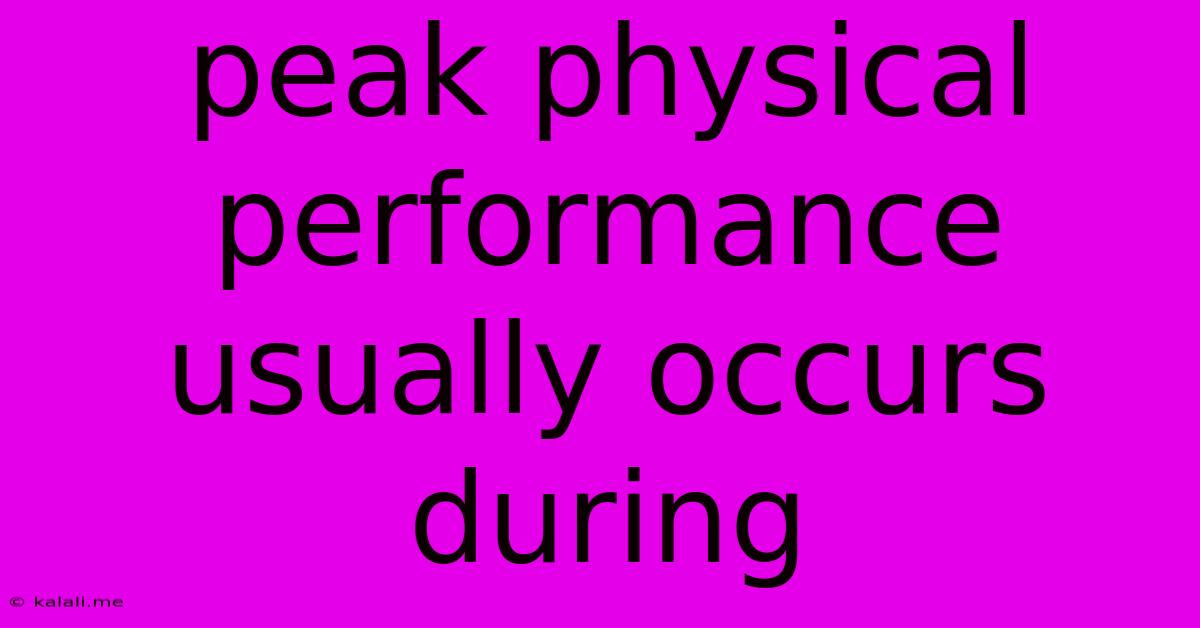Peak Physical Performance Usually Occurs During
Kalali
May 10, 2025 · 3 min read

Table of Contents
Peak Physical Performance: Usually During Your Late 20s and Early 30s?
Meta Description: Discover when athletes typically reach their peak physical performance. We explore the science behind peak athleticism, factors influencing it, and exceptions to the rule. Learn about training, genetics, and sport-specific considerations.
Many athletes and fitness enthusiasts wonder about the optimal time for peak physical performance. While there's no single magic number, research suggests a general trend: peak physical performance often occurs during the late twenties and early thirties. This isn't a hard and fast rule, however, with significant variations depending on several factors. This article delves into the science behind this phenomenon, exploring the contributing factors and highlighting exceptions to the commonly observed pattern.
The Science Behind Peak Physical Performance
Several physiological factors contribute to the typical peak performance window during the late 20s and early 30s. These include:
-
Muscle Strength and Power: Muscle strength and power generally increase throughout adolescence and early adulthood, reaching a plateau in the late 20s. While some decline can begin in the 30s, significant strength loss is usually gradual. Proper strength training can help mitigate this decline.
-
Cardiovascular Fitness: The cardiovascular system also reaches peak efficiency in this age range. Heart rate, stroke volume, and oxygen uptake (VO2 max) are all typically at their highest during this period. Consistent cardiovascular exercise can help maintain this level of fitness.
-
Reaction Time and Coordination: Neural factors, including reaction time and neuromuscular coordination, usually peak in the late 20s. These factors are crucial for many sports requiring quick reflexes and precise movements.
-
Bone Density: Bone density continues to increase until the late 20s or early 30s, contributing to strength and injury resistance. Maintaining bone health is vital throughout life, through proper nutrition and weight-bearing exercise.
Factors Influencing Peak Performance Timing
The timing of peak performance isn't solely determined by age. Several other factors significantly influence it:
-
Genetics: Genetic predisposition plays a crucial role in athletic potential and the age at which peak performance is reached. Some individuals may reach their peak earlier or later than the average.
-
Training: Rigorous and well-structured training is essential for achieving peak performance. Consistent and appropriate training schedules, tailored to the individual's sport and physiological characteristics, can significantly impact the timing and duration of peak performance. Overtraining, however, can negatively impact performance and lead to injury.
-
Sport Specificity: The timing of peak performance varies significantly across different sports. Endurance sports, like marathon running, often see peak performance later than sports requiring more power and speed. For example, a marathon runner may peak in their 30s or even later, while a sprinter might peak in their late 20s.
-
Nutrition and Recovery: Optimal nutrition and adequate recovery are crucial for maximizing athletic potential. A balanced diet, sufficient hydration, and adequate sleep are all essential for preventing injuries and promoting muscle growth and repair.
-
Injury History: Serious injuries can significantly delay or even prevent the achievement of peak physical performance. Careful injury prevention and prompt treatment are vital for athletes aiming for sustained high-level performance.
Exceptions to the Rule: Later Peak Performance
While the late 20s and early 30s are often associated with peak athletic performance, there are notable exceptions. Many endurance athletes, for instance, continue to improve and reach their peak performance in their 30s or even later. This is often attributed to the longer time required to develop the necessary endurance base and the more gradual decline in cardiovascular fitness compared to other physical attributes. Master athletes often demonstrate the incredible resilience and adaptability of the human body.
Conclusion
While the late twenties and early thirties represent a common timeframe for peak physical performance across various athletic disciplines, it's essential to understand the multifaceted factors at play. Genetics, training, sport specificity, nutrition, and injury history all contribute to the individual variability observed in the timing of peak athletic ability. Recognizing these factors allows athletes and coaches to tailor training programs and optimize performance throughout an athlete's career.
Latest Posts
Latest Posts
-
Jaguar Adaptations In The Tropical Rainforest
May 10, 2025
-
How To Find Average Velocity From Velocity Time Graph
May 10, 2025
-
What Is Non Living Things In The Ecosystem
May 10, 2025
-
How Many Fl Oz In 6 Cups
May 10, 2025
-
What Is 1 Percent Of 5000
May 10, 2025
Related Post
Thank you for visiting our website which covers about Peak Physical Performance Usually Occurs During . We hope the information provided has been useful to you. Feel free to contact us if you have any questions or need further assistance. See you next time and don't miss to bookmark.